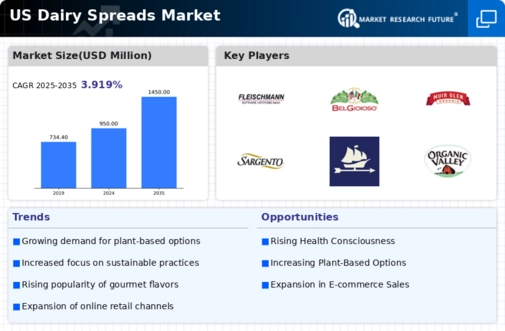Innovations in Packaging
The dairy spreads market is witnessing significant advancements in packaging technology, which plays a crucial role in attracting consumers. Innovative packaging solutions, such as resealable containers and portion-controlled packs, are becoming increasingly popular. These developments not only enhance convenience but also improve product freshness and shelf life. According to industry reports, approximately 30% of consumers consider packaging design as a key factor in their purchasing decisions. As a result, brands are investing in sustainable packaging materials to appeal to environmentally conscious consumers. This shift towards eco-friendly packaging is expected to resonate well with the growing demographic of sustainability-minded shoppers. Furthermore, effective packaging can also serve as a marketing tool, allowing brands to communicate their unique selling propositions more effectively. Thus, the focus on innovative packaging is likely to drive growth and differentiation within the dairy spreads market.
Increased Snacking Trends
The dairy spreads market is benefiting from the rising trend of snacking among consumers. As lifestyles become busier, individuals are increasingly opting for convenient snack options that are both nutritious and satisfying. Dairy spreads, often used as toppings or dips, fit well into this snacking culture. Recent surveys indicate that nearly 60% of consumers prefer snacks that provide health benefits, which positions dairy spreads favorably due to their nutritional profile. The versatility of these spreads allows them to be paired with various foods, such as crackers, fruits, and vegetables, enhancing their appeal. This trend is further supported by the growth of the snack food market, which is projected to reach $200 billion by 2026. Consequently, dairy spread manufacturers are likely to focus on developing products that cater to this snacking trend, potentially leading to increased sales and market share within the dairy spreads market.
Expansion of Distribution Channels
The dairy spreads market is experiencing a transformation in distribution channels, which is crucial for reaching a broader consumer base. The rise of e-commerce has significantly altered the retail landscape, allowing consumers to purchase dairy spreads online with ease. Recent statistics indicate that online grocery sales have surged by over 25% in the past year, highlighting the importance of digital platforms in the food sector. Additionally, traditional retail channels are also evolving, with an increase in the presence of dairy spreads in convenience stores and specialty shops. This diversification of distribution channels enables brands to cater to various consumer preferences and shopping habits. As a result, manufacturers are likely to enhance their distribution strategies to ensure product availability across multiple platforms, thereby increasing their market penetration within the dairy spreads market.
Growing Interest in Functional Foods
The dairy spreads market is increasingly influenced by the rising consumer interest in functional foods, which are perceived to offer health benefits beyond basic nutrition. This trend is driven by a growing awareness of the role of diet in overall health and wellness. Dairy spreads enriched with probiotics, vitamins, and omega-3 fatty acids are gaining traction among health-conscious consumers. Recent market analysis suggests that the functional food segment is expected to grow at a CAGR of 8% over the next five years. This presents a significant opportunity for dairy spread manufacturers to innovate and develop products that align with these health trends. By incorporating functional ingredients, brands can differentiate themselves in a competitive market and cater to the evolving preferences of consumers. Thus, the focus on functional foods is likely to shape product offerings and marketing strategies within the dairy spreads market.
Rising Demand for Natural Ingredients
The dairy spreads market is experiencing a notable shift towards natural and organic ingredients. Consumers are increasingly seeking products that are free from artificial additives and preservatives. This trend is driven by a growing awareness of health and wellness, with many individuals prioritizing clean label products. According to recent data, the organic dairy segment has seen a growth rate of approximately 10% annually, indicating a strong consumer preference for natural options. As a result, manufacturers are reformulating their dairy spreads to align with these preferences, which may enhance their market position. The emphasis on transparency in ingredient sourcing further supports this driver, as consumers demand to know the origins of their food. This focus on natural ingredients is likely to shape product development strategies within the dairy spreads market, pushing brands to innovate while adhering to these consumer expectations.

















Leave a Comment